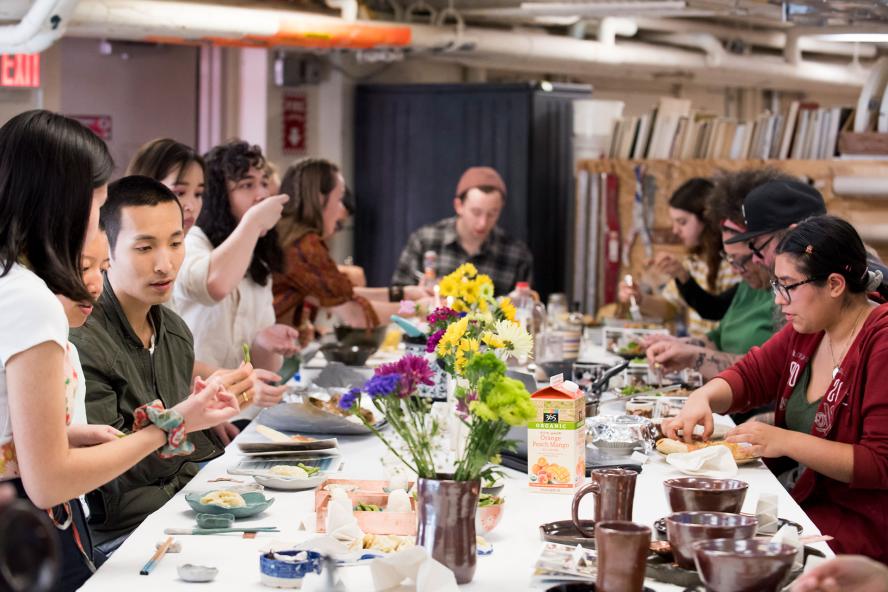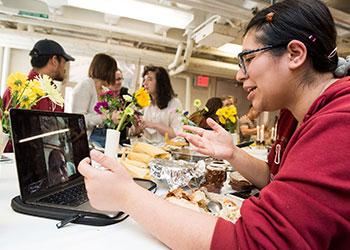Food for Thought

Deep within the School of the Museum of Fine Arts at Tufts building, surrounded by the happy hum of art studios, a feast was in full force.
Students gathered around a long rectangular table, delicately spooning gyoza onto crooked platters and fluffing jasmine rice atop an elegant metal banana leaf. One young woman lifted a tamale to her mouth, waving to her mother via Skype on a laptop propped next to her meal. Her mother—thousands of miles away in Texas—beamed.
No, this wasn't a meal at Boston's trendiest new pop-up restaurant. It was a scene from Food: The Social and Functional Politics of the Table, a new ceramics and metals course co-taught by professors of the practice Michael Barsanti and Tanya Crane that fused artistic expression with culinary exploration.
"Art is powerful, craft is powerful, and people should know how to work with their hands," Crane said.
A Storied Tradition
The class examined the intersection of food and socio-politics, translated through functional and decorative items for the table. Here, BFA and combined-degree students explored the historical significance of table vessels and cutlery for sustenance and community, designing their own pieces in ceramics and metals along the way. To cap off the course, each student devised a menu reflecting his or her cultural background for an end-of-semester banquet. Plates, utensils, and cups were all handmade.
Such a meal is part of a long tradition of people coming together over food served on objects fused with fire, said Barsanti, a ceramics expert who has taught at SMFA for 37 years.
"Ceramics dates back 26,000 years, when people started manipulating clay," he said. "Ceramics is a social instrument that brings people together. The ability to store food has advanced human technology and well-being," from tandoori ovens to kilns.
Students in the course were tasked with creating vessels emblematic of their own heritage. Some had ceramics and metal skills; others were novices. Each was asked to submit project proposals and prototypes before beginning work.
Crane, a metalsmith and jeweler, was struck by the students' devotion to such a time-consuming course. "They basically took two studio classes, which is huge," said Crane.
Despite it being a challenging course, students said it didn't feel like work. Subin Cho '22 prepared kimchi and jeon, a kimchi, squid, and onion pancake, paired with a rice drink—a replica of meals she ate in Korea before coming to the United States.
The sizzle of cooking pancakes reminded her of her grandmother. "Those boiling oils sound similar to the rain, and my grandmother would always make this dish when it rained," Cho recalled.
Cho painstakingly crafted chopsticks by hand, despite some setbacks. "Metalwork is extremely hard. It took me the whole semester to make two pairs of chopsticks, and I hurt myself a lot. I hammered myself twice and got burned," she said, adding that the end result was worth it.
Honoring the Past
Pat Mahaney, BFA + BA '20, honored their Filipino heritage by hammering and rolling a four-and-a-half-foot-long piece of sheet metal into a banana leaf platter.
"This is important because a large part of Filipino culture is kamayan, which is a traditional style of eating where you lay out many banana leaves on whatever surface you have and then place large amounts of rice and all sorts of other dishes atop it. It's a communal feast," Mahaney said.
For Mahaney, the course combined two unlikely disciplines.
"I'd never heard of a class like this, with combined mediums and a significant theme, which is food. It was very unique in that way, and I'm excited that I took it," Mahaney said. "I feel like it gave me the opportunity to explore things in my art that I probably wouldn't have on my own."
For other students, the class provided a welcome opportunity to bridge a cultural gap while far from home. Karina Ramirez, BFA + BA/BS '22, who hails from Houston, made irregularly shaped bowls to showcase her mother's favorite salsa, a specialty from her hometown of Zacatecas, Mexico.
"Most of my artistic inspiration was drawn from ornaments that we got at a flea market back home. It reminded me of my mom," Ramirez said. "She sent me pictures and told me how to arrange everything. She was very invested in what I should do, and everything I was doing was for her. This meal is for her."
Ramirez's mother joined her via Skype as a special guest, laptop propped tableside next to her daughter's plates dotted with flowers. While the flowers weren't perfect, Ramirez didn't mind.
"You could see cracks and tell it was made by hand," she said proudly. "I learned a lot about what I'm capable of doing."
Molding the Future
Other students, such as Asianna Giubardo, BFA '23, used the assignment as a socio-political statement. She contrasted angular, geometric brass forks and knives with soft, rounded bowls and paired her designs with a "consciousness bowl" filled with quinoa, roasted chickpeas, tofu, and balsamic dressing. It was a dish she enjoyed growing up as a vegetarian on Maui.
"I think food is a very reactive thing in our lives, and I think people take it for granted," Giubardo said. "A vegetarian or vegan bowl represents balance of the food groups, balance in the environment, and balance of one's self to one's surroundings. This was a staple growing up for me in my diet, and it taught me to love natural foods and foods that don't impact the environment."
Barsanti and Crane hope to teach the class again, with an even broader reach. At this year's meal, students were asked to bring one honored guest. Next year, the professors might expand the meal beyond campus.
"I'd love to involve the community beyond their peers and families, stepping out into a community where food isn't necessarily a given," Crane said.
Most of the students plan to pursue careers in art, and they expressed gratitude that the class framed their studio work within a broader social context.
"This class gave my work a purpose," Giubardo said. "Rather than creating a bowl because you have to throw, this was about creating a bowl so you can serve someone and have a discussion about where food comes from. In a cultural sense, this class made it even more appealing to make things."

